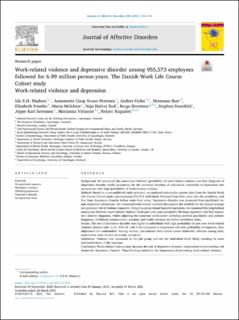| dc.contributor.author | Madsen, Ida E.H. | |
| dc.contributor.author | Svane-Petersen, Annemette Coop | |
| dc.contributor.author | Holm, Anders | |
| dc.contributor.author | Burr, Hermann | |
| dc.contributor.author | Framke, Elisabeth | |
| dc.contributor.author | Melchior, Maria | |
| dc.contributor.author | Rod, Naja Hulvej | |
| dc.contributor.author | Sivertsen, Børge | |
| dc.contributor.author | Stansfeld, Stephen A. | |
| dc.contributor.author | Sørensen, Jeppe Karl | |
| dc.contributor.author | Virtanen, Marianna | |
| dc.contributor.author | Rugulies, Reiner | |
| dc.date.accessioned | 2022-02-15T08:19:05Z | |
| dc.date.available | 2022-02-15T08:19:05Z | |
| dc.date.created | 2021-08-18T16:42:24Z | |
| dc.date.issued | 2021 | |
| dc.identifier.citation | Journal of Affective Disorders. 2021, 288 136-144. | en_US |
| dc.identifier.issn | 0165-0327 | |
| dc.identifier.uri | https://hdl.handle.net/11250/2978944 | |
| dc.description.abstract | Background We examined the association between probability of work-related violence and first diagnosis of depressive disorder whilst accounting for the potential selection of individuals vulnerable to depression into occupations with high probability of work-related violence. Methods Based on a pre-published study protocol, we analysed nationwide register data from the Danish Work Life Course Cohort study, encompassing 955,573 individuals followed from their entry into the workforce, and free from depressive disorder before work-force entry. Depressive disorder was measured from psychiatric in- and outpatient admissions. We measured work-related violence throughout the worklife by the annual average occupational risk of violence exposure. Using Cox proportional hazards regression, we examined the longitudinal association between work-related violence (both past year and cumulative life-long exposure) and first depressive disorder diagnosis, whilst adjusting for numerous confounders including parental psychiatric and somatic diagnoses, childhood socioeconomic position, and health services use before workforce entry. Results The risk of depressive disorder was higher in individuals with high probability of past year work-related violence (hazard ratio: 1.11, 95% CI: 1.06-1.16) compared to employees with low probability of exposure, after adjustment for confounders. Among women, associations were robust across industries, whereas among men, associations were limited to certain industries. Limitations Violence was measured on the job group and not the individual level, likely resulting in some misclassification of the exposure. Conclusions Work-related violence may increase the risk of depressive disorder, independent of pre-existing risk factors for depressive disorder. These findings underline the importance of preventing work-related violence. | en_US |
| dc.language.iso | eng | en_US |
| dc.publisher | Elsevier | en_US |
| dc.rights | Attribution-NonCommercial-NoDerivatives 4.0 Internasjonal | * |
| dc.rights.uri | http://creativecommons.org/licenses/by-nc-nd/4.0/deed.no | * |
| dc.title | Work-related violence and depressive disorder among 955,573 employees followed for 6.99 million person-years. The Danish Work Life Course Cohort study: Work-related violence and depression | en_US |
| dc.type | Peer reviewed | en_US |
| dc.type | Journal article | en_US |
| dc.description.version | publishedVersion | en_US |
| dc.source.pagenumber | 136-144 | en_US |
| dc.source.volume | 288 | en_US |
| dc.source.journal | Journal of Affective Disorders | en_US |
| dc.identifier.doi | 10.1016/j.jad.2021.03.065 | |
| dc.identifier.cristin | 1927050 | |
| dc.relation.project | Nordforsk: 75021 | en_US |
| cristin.ispublished | true | |
| cristin.fulltext | original | |
| cristin.qualitycode | 1 | |

